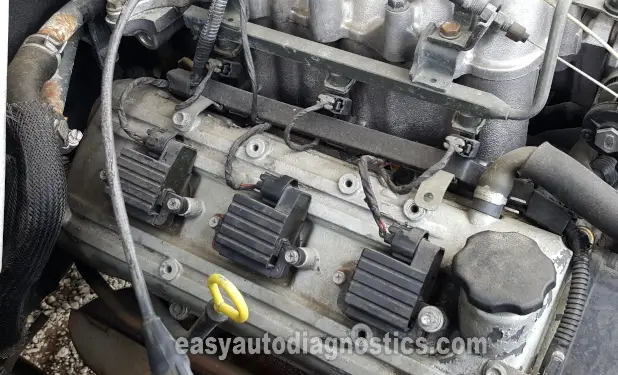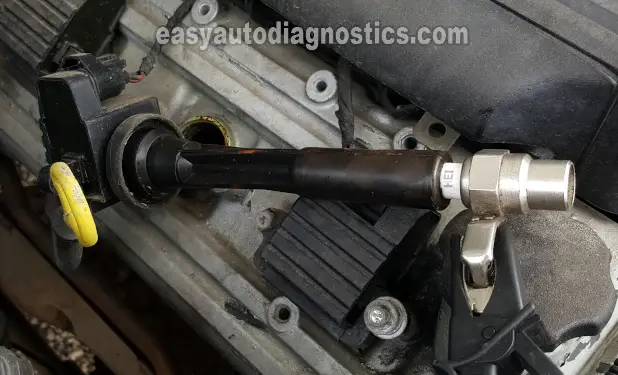
This tutorial will help you to diagnose a bad Coil-On-Plug ignition coil that may be causing a misfire condition on your 1996, 1997, 1998, 1999 3.2L Isuzu Amigo, Rodeo, Trooper or Honda Passport.
All of the tests are designed to make your troubleshooting as easy and as pain free as possible. You'll be able to find out if you've got a bad ignition coil (or not) on your hands.
Contents of this tutorial:
- Common Symptoms Of A Bad Coil-On-Plug Ignition Coil.
- What Tools Do I Need?
- Circuit Descriptions Of The C-O-P Ignition Coil Connector.
- Where To Buy The Ignition Coils And Save.
- TEST 1: Testing The Ignition Coil For Spark.
- TEST 2: Making Sure The Ignition Coil Is Getting 12 Volts.
- TEST 3: Making Sure The Ignition Coil Is Getting Ground.
- TEST 4: Testing For The Presence Of The Activation Signal.
- TEST 5: Testing The Activation Signal Without A Multimeter.
- TEST 6: Checking For Carbon Tracks.
- More 3.2L Isuzu Diagnostic Tutorials.
![]() You can find this tutorial in Spanish here: Cómo Probar Las Bobinas De Encendido (1996-1999 3.2L Isuzu Rodeo y Trooper) (at: autotecnico-online.com).
You can find this tutorial in Spanish here: Cómo Probar Las Bobinas De Encendido (1996-1999 3.2L Isuzu Rodeo y Trooper) (at: autotecnico-online.com).
APPLIES TO: This tutorial applies to following vehicles, since they use the same ignition coils:
- 3.2L V6 Isuzu Amigo: 1998, 1999.
- 3.2L V6 Isuzu Rodeo: 1996, 1997, 1998, 1999.
- 3.2L V6 Isuzu Trooper: 1996, 1997.
- 3.2L V6 Honda Passport: 1996, 1997, 1998, 1999.
Common Symptoms Of A Bad Coil-On-Plug Ignition Coil
When an ignition coil fails, it'll cause the engine to misfire. This misfire will cause the fuel injection computer to set a misfire code that'll light up the check engine light (CEL) on your instrument cluster:
- P0300: Random Cylinder Misfire.
- P0301: Cylinder #1 Misfire.
- P0302: Cylinder #2 Misfire.
- P0303: Cylinder #3 Misfire.
- P0304: Cylinder #4 Misfire.
- P0305: Cylinder #5 Misfire.
- P0306: Cylinder #6 Misfire.
Besides a misfire problem, you'll also see one or more of the following symptoms:
- Engine misfire that DOES NOT light up the check engine light (CEL).
- Smell of unburned gasoline coming out of the tailpipe.
- Rotten egg smell coming out of the tailpipe. This is due to the unburned gasoline from the misfiring cylinder over loading the catalytic converter.
- Really bad gas mileage.
- Lack of power as you accelerate the vehicle down the road.
What Tools Do I Need?
A scan tool, although a very handy tool to own, is not needed. Even if you suspect a misfire, you don't need a scan tool to find out which cylinder is the one that is misfiring. You can perform the cylinder balance test yourself on your 3.2L V6 Isuzu Amigo, Rodeo, or Trooper (and 3.2L Honda Passport), TEST 1 will help you with this. You'll need:
- An HEI spark tester.
- Battery jump start cables.
- A digital multimeter.
- This multimeter must be able to read Hertz frequency.
- A repair manual.
- For whatever remove and replace info you'll need that is not covered by this article.
You're gonna' need a helper. This helper will help you crank the engine while you perform the tests in the engine compartment.
Circuit Descriptions Of The C-O-P Ignition Coil Connector
The 1996-1997 3.2L V6 Isuzu ignition coil differs from the 1997-1998 3.2L V6 Isuzu ignition coil.
In photo 1 of 2 (above), the connector and ignition coil belong to the 1996-1997 3.2L Isuzu Rodeo, Isuzu Trooper, and Honda Passport.
Photo 2 of 2 shows the connector and ignition coil of the 1998-1999 3.2L Isuzu Amigo, Isuzu Rodeo, and Honda Passport.
Here's a brief description of each of the terminals of the connector:
| 1996-1997 Ignition Coil Connector | |
|---|---|
| Pin | Description |
| 1 | 12 Volts |
| 2 | Activation Signal |
| 3 | Ground |
| 1998-1999 Ignition Coil Connector | |
|---|---|
| Pin | Description |
| 1 | Activation Signal |
| 2 | 12 Volts |
| 3 | Ground |
Where To Buy The Ignition Coils And Save
The following links will help you comparison shop for the ignition coils:
1996-1997 3.2L Isuzu Rodeo, Trooper, and Honda Passport:
Disclosure: As an Amazon Associate, I earn from qualifying purchases. Buying through these links helps support this site at no extra cost to you. Thanks for your support —it really means a lot!
1998-1999 3.2L Isuzu Amigo, Rodeo, Trooper, and Honda Passport:
Disclosure: As an Amazon Associate, I earn from qualifying purchases. Buying through these links helps support this site at no extra cost to you. Thanks for your support —it really means a lot!
TEST 1: Testing The Ignition Coil For Spark

The first thing we're gonna' do is to test the ignition coils for spark. I recommend you test all six ignition coils.
If you want to test a specific ignition coil, instead of all of them, no worries. You can test just the one or ones you want.
Here a few suggestions that'll help you obtain the correct test result from your spark tests:
- Do not use a regular spark plug instead of a dedicated spark tester. The result you may get from using a regular spark plug IS NOT trustworthy.
- Do not pull the ignition coil off of its spark plug, as the engine is running, to see/hear if it's sparking. This method can ruin/fry the ignition coil and now you've got another problem on your hands.
- I recommend using an HEI spark tester for the spark tests. You can see an example of this spark tester and where to buy it here: HEI Spark Tester.
These are the test steps:
- 1
Remove the first ignition coil that you're going to test.
- 2
Attach the HEI spark tester (or an equivalent spark tester) to the ignition coil as shown in the photo above.
- 3
Connect the spark tester to the battery negative (-) terminal. You can do this with a battery jump start cable (my preferred method).
- 4
Have your helper crank the engine while you observe the spark tester.
- 5
You're gonna' get one of two results: spark or no spark.
- 6
Disconnect the spark tester from the ignition coil and put the ignition coil back in place.
- 7
Repeat the spark test on the remaining ignition coils.
Let's examine your test results:
CASE 1: All six ignition coils sparked. This is the correct and expected test result.
With this test result you can conclude that all 6 ignition coils are good. The cause of the misfire is something else. Take a look at the suggestions here: TEST 6: Checking For Carbon Tracks.
CASE 2: You got spark from some but NOT all of ignition coils. The ones that did not fire off spark are probably bad.
To make sure, you need to verify that the ignition coil (the one that did not spark) is receiving 12 Volts, Ground and a activation signal. Go to: TEST 2: Making Sure The Ignition Coil Is Getting 12 Volts.
CASE 3: You got NO spark from none of the ignition coils. It is rare (next to impossible) for all of the ignition coils to go bad at the exact same time.
The most likely causes of this are:
- A bad crankshaft position sensor.
- A bad ignition switch.
- A blown fuse.






